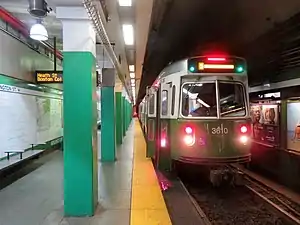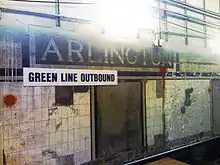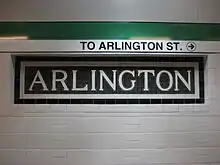Arlington station (MBTA)
Arlington is a station on the light rail MBTA Green Line. located at the southwest corner of the Boston Public Garden at the corner of Arlington and Boylston Streets at the east end of the Back Bay neighborhood of Boston, Massachusetts. Arlington was not part of the 1914-opened Boylston Street subway; its construction was delayed by World War I and the station opened in 1921.
Arlington | ||||||||||||||||||||||||||
|---|---|---|---|---|---|---|---|---|---|---|---|---|---|---|---|---|---|---|---|---|---|---|---|---|---|---|
 An outbound train at Arlington station in July 2019 | ||||||||||||||||||||||||||
| Location | 20 Arlington Street, Boston, Massachusetts | |||||||||||||||||||||||||
| Coordinates | 42.35186°N 71.070728°W | |||||||||||||||||||||||||
| Line(s) | Boylston Street subway | |||||||||||||||||||||||||
| Platforms | 2 side platforms | |||||||||||||||||||||||||
| Tracks | 2 | |||||||||||||||||||||||||
| Connections | ||||||||||||||||||||||||||
| Construction | ||||||||||||||||||||||||||
| Disabled access | Yes | |||||||||||||||||||||||||
| History | ||||||||||||||||||||||||||
| Opened | November 13, 1921[1] | |||||||||||||||||||||||||
| Rebuilt | May 31, 2009 | |||||||||||||||||||||||||
| Passengers | ||||||||||||||||||||||||||
| FY2019 | 6,813 (weekday average boardings)[2] | |||||||||||||||||||||||||
| Services | ||||||||||||||||||||||||||
| ||||||||||||||||||||||||||
| ||||||||||||||||||||||||||
Station layout

Arlington station has two side platforms serving the two tracks of the Boylston Street subway, located under the east half of the block of Boylston Street between Arlington Street and Berkeley Street. A fare mezzanine is located under the intersection of Arlington Street and Boylston Street. The mezzanine is connected to the platforms with stairs, elevators, and exit-only escalators. Five stairway entrances are located around the mezzanine; another stairway and the surface elevator are located further west on the north side of Boylston Street, connected to the mezzanine by a passageway. A closed passageway formerly led to an entrance from the Public Garden.
A smaller fare mezzanine is located at Berkeley Street and connected to the platforms with a long corridor. This entrance does not have elevators for accessibility and is not open in normal use. The MBTA plans to add elevators to the Berkeley Street lobby and reopen it as a full entrance. A design contract was awarded in April 2020.[3]
History


After the success of the original Tremont Street subway in 1897–1898, there was a push to extend the tunnel under Boylston Street towards Kenmore Square.[4] During 1913 tunnel excavations near the present-day site of Arlington station, remains of ancient fish weirs built by Native Americans were found approximately 30 feet (9.1 m) below street level. Their age has been estimated as between 2,000 and 3,600 years.[4][5]
Businesses in the Back Bay neighborhood along Boylston Street between Clarendon and Tremont Streets became worried about loss of income due to being bypassed by an uninterrupted 4,000-foot (1,200 m) tunnel between Boylston and Copley stations, which was completed in 1914. They lobbied for an infill station near Arlington Street, but were rebuffed by the Boston Elevated Railway and the state legislature. In 1915, with the backing of Boston mayor James Michael Curley, they succeeded in getting legislative approval for a new underground station.[4]
After delays caused by World War I, Arlington station finally opened in 1921, and remained in continuous use through its first major renovation, in 1967.[6][1] The Berkeley Street entrance was closed on January 3, 1981 as part of extensive cutbacks that including closing Bowdoin and Symphony.[7]
1960s renovations
The MBTA wanted to improve its graphic design in the early 1960s, so they hired Cambridge Seven Associates graphic designers to make it easier for people to understand. Arlington was used as their pilot project for testing modernization ideas, including the (T) "lollipop" sign, the colored walls and signage distinction between "inbound" vs "outbound", the high-contrast photographs on the walls, and the colored bands along the wall and above the entrances.[8] At the platform level, the wall at the inbound end of the station was painted with "warm" colors red and orange, while the outbound end was painted with "cool" colors blue and green.[8] The A dedication ceremony was held on August 17, 1968, with the renovation fully completed in 1968.[9][10]
A secondary name of Park Plaza, used on some station signage, was added in 1985 as part of a series of station name changes.[11]
2006–2009 renovations
On November 22, 2006, the MBTA closed the Arlington Street entrance to the station to begin a major renovation of the station.[12] Conducted in concert with similar changes to Copley, the project added elevators and raised platforms to make the station accessible. The street elevator was placed in front of the Arlington Street Church along with a new set of stairs, and the northwest entrance was relocated. The 1981-closed Berkeley Street entrance was reopened for the duration of the project.[12]
On May 31, 2009, the renovated main entrances on Arlington Street reopened for public use; the Berkeley Street entrances were reverted to emergency-only exits.[13][14] Panels of artwork were added to the station at the platform level. Designed by Ross Miller, these panels explain and celebrate the ancient Boylston Street Fishweir that had been discovered during excavations in the vicinity.[15][16]
References
- Belcher, Jonathan. "Changes to Transit Service in the MBTA district" (PDF). NETransit.
- "A Guide to Ridership Data". MassDOT/MBTA Office of Performance Management and Innovation. June 22, 2020. p. 8.
- Schwarz, John (April 13, 2020). "MBTA Contract Nos. A90PS02, A90PS04, & A90PS05: Architectural and Engineering Services for Station and Accessibility Improvements" (PDF). Massachusetts Bay Transportation Authority.
- Koebel, Romin (2005). "Boston Transit Milestones". MIT Open Courseware. Archived from the original on 2006-09-20. Retrieved 2012-08-01.
- Decima, Elena B.; Dincauze, Dena F. "The Boston Back Bay Fish Weirs" (PDF). Retrieved 2015-05-08.
- "Officials Celebrate Modernization of Arlington Station". MBTA.com. Massachusetts Bay Transportation Authority. 2009-06-01. Retrieved 2015-05-08.
- "Bowdoin, Symphony T stations closed today". Boston Globe. January 3, 1981 – via Newspapers.com. (second page)

- Byrnes, Mark. "The Minds Behind Boston's 'T'". CityLab. Retrieved 2019-04-11.
- "MBTA Modernization". Cambridge Seven Associates. Archived from the original on February 14, 2016.
- A Chronicle of the Boston Transit System. Massachusetts Bay Transportation Authority. 1981. p. 7 – via Internet Archive.
- Crocket, Douglas S. (July 27, 1985). "T board votes to change the names of some stations". Boston Globe. p. 26 – via Newspapers.com.

- "Arlington Station". Massachusetts Bay Transportation Authority. Archived from the original on February 16, 2007.
- Bierman, Noah (June 2, 2009). "Arlington T station reopens with disabled access". Boston Globe. Archived from the original on June 6, 2009.
- "Officials Celebrate Modernization of Arlington Station" (Press release). Massachusetts Bay Transportation Authority. June 1, 2009.
- "Ancient Fishweir Murals". Museum Without Walls. cultureNOW. Retrieved 2015-05-08.
- Annear, Steve (January 4, 2013). "Hidden Images at MBTA Green Line Station Reveal Deep History of Boston's Back Bay". BostInno. Streetwise Media. Retrieved 2015-05-08.
External links
| Wikimedia Commons has media related to Arlington station (MBTA). |